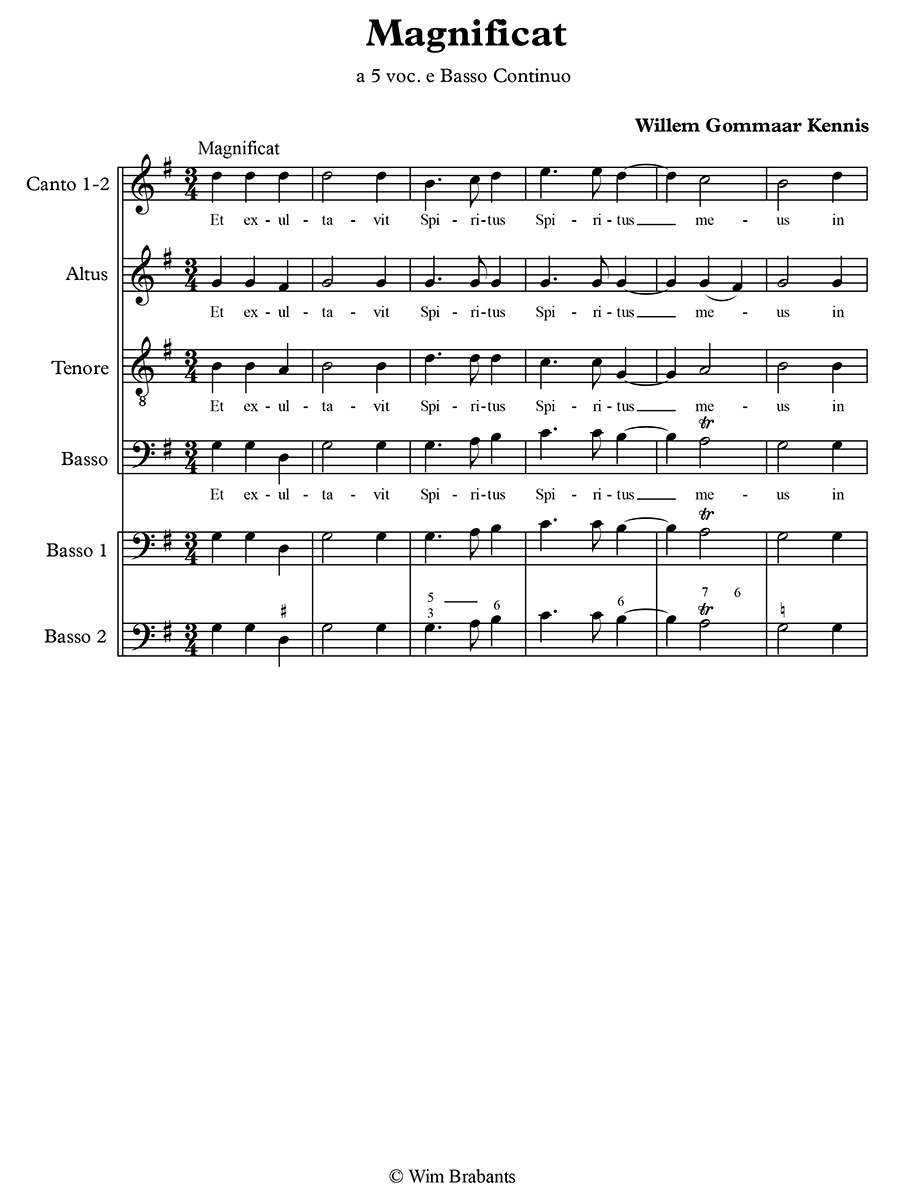Magnificat (Performance Score / first print)
Kennis, Willem Gommaar
12,00 €
Preface
Willem Gommaar Kennis
(Lier, 1717 – Leuven, 1789)
Magnificat
Willem Gommaar Kennis, already a violinist with the St Gummarus church orchestra at age eleven, was appointed chapel master on 2 March 1742. The preserved appointment deed stipulated that he was expected to teach the choir boys to read and write, to attend church services on a regular basis, to compose music and leave it for free on the singers’ tribune. There are only eight known vocal works, including a Magnificat, a Salve Regina and a Te Deum, which are being published for the first time in this series. The works are kept in the archives of the Antwerp cathedral, preserved in the library of the Royal Conservatoire of Antwerp, and come from the estate of Willem Jacobus Josephus Kennis (Leuven, 1768 – Antwerp, 1845), a son from Willem Gommaar’s second marriage of. After he left Leuven, where he had succeeded his father as chapel master of the St Peter’s Church from 1789 to 1798, Willem became chapel master of Antwerp cathedral, where he served from 1803 to 1845.
In the Magnificat only the even numbered verses of the liturgical text are arranged for five voices and basso continuo: Et exultavit (tutti), Quia fecit (solo), Fecit potentiam (tutti), Esurientes (trio), Sicut locutus (solo), Sicut erat (tutti).
At the same time, Willem Gommaar Kennis became well-known as a proficient violinist. Antonius Nollekens, the vicar of St Gummarus Church during Kennis’s time there, notes in his diary that mid-May 1746, Kennis gave a recital for Louis XV, who was staying at the Court of Boechout at the time: ‘Het talent van den heer Kennis werd zo opgezet, dat den koning den violist wilde hooren en hem zijne carosse naar Bouchout liet halen’ (‘Word of Mr Kennis’s talent was such that the king wanted to hear the violinist play and had his carriage fetch him and bring him to Boechout’).
With the publication, between 1744 and 1749, of three instrumental compositions, Kennis made a name for himself as violin virtuoso and composer: opus 1, six violin sonatas (Liège); opus 2, six trio sonatas for two violins and basso continuo (Brussels); opus 3, six violin sonatas (Leuven). From 1749 until his death in 1789, Kennis was chapel master of St Peter’s Church in Leuven. The only known compositions by him from that period are instrumental: three collections of six violin duets each and three other collections, of six trio sonatas, six symphonies and six string quartets. On their title pages, Kennis refers to himself as ‘Maître de musique de l’église collégiale de St. Pierre à Louvain’.
Apparently, his music was greatly appreciated, as several of his collections were also published in Paris and London. The London edition of opus 4 (six violin duets) was for some time even attributed to Johann Christian Bach. The famous English music historian Charles Burney, who had also briefly visited Leuven (late July 1772) on his music travels through the Southern Netherlands, wrote in his diary The Present State of Music in Germany, the Netherlands and United Provinces (London, 1773): ‘M. Kennis is the most remarkable performer on the violin in point of execution, not only of Lovain, but of all this part of the world. The solos he writes for his own instrument and hand, are so difficult, that no one hereabouts attempts them but himself.’
Gilbert Huybens
(translation: Isobel Mackie)
World premiere recording by Euterpe Baroque Consort & Utopia – Bart Rodyns, Phaedra – ‘In Flanders’ Fields’, volume 93 (www.phaedracd.com)
This score was published in collaboration with the Study Centre for Flemish Music (www.svm.be) and Labo XIX&XX, a research group of the library of the Royal Conservatoire of Antwerp, with the support of the Ministry of the Flemish Community, Festival van Vlaanderen – Mechelen/Kempen, and Erfgoedcel Kempens Karakter. Bart Rodyns and Wim Brabants created this score based on the autographic copy, which is housed in the library of the Royal Conservatoire of Antwerp.
Score Data
| Special Edition | The Flemish Music Collection |
|---|---|
| Genre | Choir/Voice & Instrument(s) |
| Size | 225 x 320 mm |
| Printing | First print |
| Specifics | Performance Score |
| Pages | 16 |
